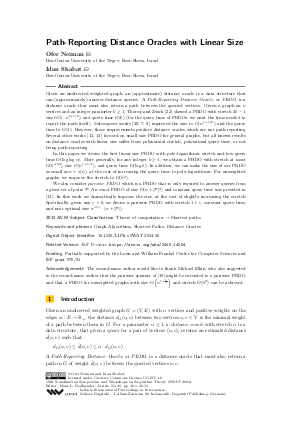@InProceedings{neiman_et_al:LIPIcs.SWAT.2024.36,
author = {Neiman, Ofer and Shabat, Idan},
title = {{Path-Reporting Distance Oracles with Linear Size}},
booktitle = {19th Scandinavian Symposium and Workshops on Algorithm Theory (SWAT 2024)},
pages = {36:1--36:16},
series = {Leibniz International Proceedings in Informatics (LIPIcs)},
ISBN = {978-3-95977-318-8},
ISSN = {1868-8969},
year = {2024},
volume = {294},
editor = {Bodlaender, Hans L.},
publisher = {Schloss Dagstuhl -- Leibniz-Zentrum f{\"u}r Informatik},
address = {Dagstuhl, Germany},
URL = {https://drops.dagstuhl.de/entities/document/10.4230/LIPIcs.SWAT.2024.36},
URN = {urn:nbn:de:0030-drops-200760},
doi = {10.4230/LIPIcs.SWAT.2024.36},
annote = {Keywords: Graph Algorithms, Shortest Paths, Distance Oracles}
}

 Creative Commons Attribution 4.0 International license
Creative Commons Attribution 4.0 International license







